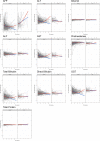Accurate prediction of HCC risk after SVR in patients with hepatitis C cirrhosis based on longitudinal data
- PMID: 38007418
- PMCID: PMC10676612
- DOI: 10.1186/s12885-023-11628-1
Accurate prediction of HCC risk after SVR in patients with hepatitis C cirrhosis based on longitudinal data
Abstract
Background: Most existing predictive models of hepatocellular carcinoma (HCC) risk after sustained virologic response (SVR) are built on data collected at baseline and therefore have limited accuracy. The current study aimed to construct an accurate predictive model incorporating longitudinal data using a novel modeling strategy. The predictive performance of the longitudinal model was also compared with a baseline model.
Methods: A total of 400 patients with HCV-related cirrhosis who achieved SVR with direct-acting antivirals (DAA) were enrolled in the study. Patients were randomly divided into a training set (70%) and a validation set (30%). Informative features were extracted from the longitudinal variables and then put into the random survival forest (RSF) to develop the longitudinal model. A baseline model including the same variables was built for comparison.
Results: During a median follow-up time of approximately 5 years, 25 patients (8.9%) in the training set and 11 patients (9.2%) in the validation set developed HCC. The areas under the receiver-operating characteristics curves (AUROC) for the longitudinal model were 0.9507 (0.8838-0.9997), 0.8767 (0.6972,0.9918), and 0.8307 (0.6941,0.9993) for 1-, 2- and 3-year risk prediction, respectively. The brier scores of the longitudinal model were also relatively low for the 1-, 2- and 3-year risk prediction (0.0283, 0.0561, and 0.0501, respectively). In contrast, the baseline model only achieved mediocre AUROCs of around 0.6 (0.6113, 0.6213, and 0.6480, respectively).
Conclusions: Our longitudinal model yielded accurate predictions of HCC risk in patients with HCV-relate cirrhosis, outperforming the baseline model. Our model can provide patients with valuable prognosis information and guide the intensity of surveillance in clinical practice.
Keywords: Direct-acting antivirals; Hepatocellular carcinoma; Longitudinal study; Machine learning; Predictive models.
© 2023. The Author(s).
Conflict of interest statement
The authors declare no competing interests.
Figures



Similar articles
-
Prediction of Hepatocellular Carcinoma Development in Korean Patients after Hepatitis C Cure with Direct-Acting Antivirals.Gut Liver. 2024 Jan 15;18(1):147-155. doi: 10.5009/gnl220386. Epub 2023 Apr 20. Gut Liver. 2024. PMID: 37076993 Free PMC article.
-
Personalized surveillance for hepatocellular carcinoma in cirrhosis - using machine learning adapted to HCV status.J Hepatol. 2020 Dec;73(6):1434-1445. doi: 10.1016/j.jhep.2020.05.052. Epub 2020 Jun 29. J Hepatol. 2020. PMID: 32615276
-
Human Immunodeficiency Virus (HIV) Infection Is Associated With Lower Risk of Hepatocellular Carcinoma After Sustained Virological Response to Direct-acting Antivirals in Hepatitis C Infected Patients With Advanced Fibrosis.Clin Infect Dis. 2021 Oct 5;73(7):e2109-e2116. doi: 10.1093/cid/ciaa1111. Clin Infect Dis. 2021. PMID: 32766891
-
Hepatocellular carcinoma and hepatitis C virus treatments: The bold and the beautiful.J Viral Hepat. 2023 Feb;30(2):148-159. doi: 10.1111/jvh.13778. Epub 2022 Dec 12. J Viral Hepat. 2023. PMID: 36461645 Review.
-
The impact of treatment of hepatitis C with DAAs on the occurrence of HCC.Liver Int. 2018 Feb;38 Suppl 1:139-145. doi: 10.1111/liv.13659. Liver Int. 2018. PMID: 29427487 Review.
Cited by
-
Assessment of Albumin-Incorporating Scores at Hepatocellular Carcinoma Diagnosis Using Machine Learning Techniques: An Evaluation of Prognostic Relevance.Bioengineering (Basel). 2024 Jul 28;11(8):762. doi: 10.3390/bioengineering11080762. Bioengineering (Basel). 2024. PMID: 39199720 Free PMC article.
-
Prevention of liver cancer in the era of next-generation antivirals and obesity epidemic.Hepatology. 2025 Jan 14:10.1097/HEP.0000000000001227. doi: 10.1097/HEP.0000000000001227. Online ahead of print. Hepatology. 2025. PMID: 39808821 Free PMC article.
-
The Natural History of Hepatitis C Virus Infection and Disease in the Era of Curative Therapy with Direct-Acting Antivirals.Viruses. 2025 Feb 26;17(3):319. doi: 10.3390/v17030319. Viruses. 2025. PMID: 40143248 Free PMC article. Review.
-
Prognosis Following Sustained Virologic Response in Korean Chronic Hepatitis C Patients Treated with Sofosbuvir-Based Treatment: Data from a Multicenter Prospective Observational Study up to 7 Years.Medicina (Kaunas). 2024 Jul 14;60(7):1132. doi: 10.3390/medicina60071132. Medicina (Kaunas). 2024. PMID: 39064561 Free PMC article.
-
Shear-wave elastography to predict hepatocellular carcinoma after hepatitis C virus eradication: A systematic review and meta-analysis.World J Gastroenterol. 2024 Mar 14;30(10):1450-1460. doi: 10.3748/wjg.v30.i10.1450. World J Gastroenterol. 2024. PMID: 38596502 Free PMC article.
References
MeSH terms
Substances
Grants and funding
- 82273691/National Natural Science Foundation of China
- BK20190106/Natural Science Foundation of Jiangsu Province
- PAPD/Priority Academic Program Development of Jiangsu Higher Education Institutions
- 2021-11005/Nanjing Important Science & Technology Specific Projects
- 81703273/National Natural Youth Science Foundation of China
LinkOut - more resources
Full Text Sources
Medical

